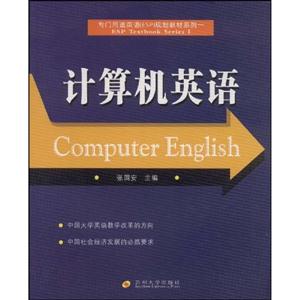-
>
鲍勃·迪伦诗歌集:1961-2012:典藏版
-
>
双城记-英文版
-
>
四级词汇词根+联想记忆法:乱序版
-
>
The secret garden
-
>
哈克贝利.费恩历险记/床头灯英语.2000词读物(英汉对照)
-
>
10000德语分类词汇联想记忆
-
>
英语词汇全书
计算机英语 版权信息
- ISBN:9787811372830
- 条形码:9787811372830 ; 978-7-81137-283-0
- 装帧:暂无
- 册数:暂无
- 重量:暂无
- 所属分类:>>
计算机英语 本书特色
《计算机英语》中国大学英语教学改革的方向,中国社会经济发展的必然要求。
计算机英语 内容简介
本书力图向读者介绍计算机科学的全貌,即在计算机环境下如何解决问题和有效地完成任务。由于计算机知识的多样性,本书无法只介绍其中某一方面的问题,而是尽可能地描述计算机科学的发展,读者从中可以看清计算机发展的脉络。 本书覆盖了离散数学、算法、编程方法学、面向对象程序设计、操作系统、科学计算这样一些传统意义上的计算机科学理论,也涉及到计算机图形学、多媒体、人工智能、计算机网络这些新议题,更加进了述录系统、语音技术、网络安全、应用程序、微控制器这样一些应用实例。这样的编排是为了拓展读者的视野一,从中发现自己感兴趣的问题。 与其他计算机英语教科书不同的是,本书是按照简单的全反应式模型来编写的,与其说这是一本英语书,不如说这是用英语编写的介绍计算机科学的引论。本书不再介绍英语语法,但教师还是应当对复杂的语法现象做深入分析,这既是理解上下文的需要,也是提高英语阅读能力所必须的。从学习者的角度来看,这使解释更清晰,读者把握内容更全面。从教学的角度看,这样的做法为教师提供了一种自然的循序渐进的教学方法,从而讲授那些难于掌握的材料。 本书分成20个单元,每个单元包含3篇文章,text a和text b给出了一些关键词汇和短语,对较为深入的问题作了注解,并安排少量问题。读者除了用英文完成那些问题外,还应自主查找相关资料。这些问题有些涉及计算机的专门知识,有些是为了提高英语应用水平。使用本书并不需要计算机科学基本知识以外的其他预先知识。当然,已经学了一些计算机基础知识会有助于理解本书中一些实际应用方面的材料。
计算机英语 目录
计算机英语 节选
《计算机英语》覆盖了离散数学、算法、编程方法学、面向对象程序设计、操作系统、科学计算这样一些传统意义上的计算机科学理论,也涉及到计算机图形学、多媒体、人工智能、计算机网络这些新议题,更加进了述录系统、语音技术、网络安全、应用程序、微控制器这样一些应用实例。这样的编排是为了拓展读者的视野一,从中发现自己感兴趣的问题。
计算机英语 相关资料
插图:So far, we've looking at various CPU instructions and how to represent themin memory. Basically, we've been looking at the machine language of the68,000. That is, the language that the 68,000 inherently understands. This isall fine and dandy if you're actually setting the bits in a computer's memory byhand. However, more often than not, you don't end up programming this way.In order to make it easier to program computers, someone came up with thebright idea of creating an assembler. An assembler is able to take machineinstructions in a human-readable form and translate them into binaryautomatically. That's about a million times better than machine language.However, it's quite easy to do. An assembly language is simply a syntax forspecifying machine instructions. That means that you can convert to assemblylanguage to machine language with just a simple encoding of the machinelanguage instructions. In fact, by definition all assembly language instructions havea one-to-one mapping to machine language. In other words, the assemblerdoesn't need any smarts——it just needs to know the translation.Having assembly languages is great, but there is still something missing. It'sstill difficult to get things done in assembly, plus every processor has a differentassembly language (they have to because they all have different machinelanguages). That means that if you write some code for one processor, you haveto completely re-write it if you change processors.Over time, people developed higher-level languages, such as Fortran, C,Pascal, Java, VisualBasic. You should be familiar with at least one of theselanguages (namely C, since it's a prerequisite for the class). These higher-levellanguages are great because they make programming easier and also allow for some) portability between processors. One interesting point is that in higher-level languages, one statement can translate into numerous
- >
罗曼·罗兰读书随笔-精装
罗曼·罗兰读书随笔-精装
¥40.6¥58.0 - >
有舍有得是人生
有舍有得是人生
¥31.5¥45.0 - >
月亮与六便士
月亮与六便士
¥13.4¥42.0 - >
姑妈的宝刀
姑妈的宝刀
¥11.4¥30.0 - >
烟与镜
烟与镜
¥20.6¥48.0 - >
月亮虎
月亮虎
¥17.8¥48.0 - >
巴金-再思录
巴金-再思录
¥33.1¥46.0 - >
名家带你读鲁迅:故事新编
名家带你读鲁迅:故事新编
¥13.0¥26.0
-
2022图书×抽奖盲袋
¥9.9¥25 -
2023读书月阅读盲盒——天黑,闭眼,刀谁?
¥42.3¥158 -
2022读者节纪念徽章-三星会员专属
¥45¥45.6 -
2023读书月阅读盲盒——我什么场面没见过?
¥42.3¥158 -
2023读书月阅读盲盒——去码头整点什么薯条?
¥42.3¥158
















